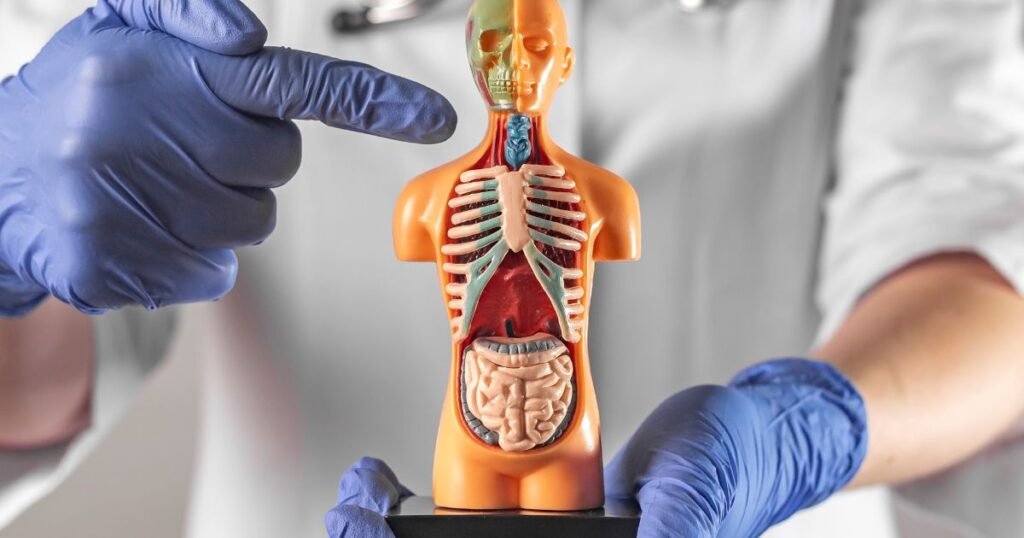The Endocrine System Function technically is not a part of the nervous system; however, they are closely related to the autonomic nervous system. Endocrine system consists of glands that secrete chemical messengers into the bloodstream. These, in turn, have specific effects on various organs and tissues.
The Endocrine System Diagram

The most important gland of endocrine system are the pituitary the adrenal glands, the thyroid and the gonads. Both the central and peripheral nervous system work closely with the endocrine system. The hormone secreted by glands is responsible for the process of homeostasis which maintains the proper balance in the internal bodily states.
It provides the mechanism by which the brain exercise control over the endocrine system exerts control over the brain as well: the other types of glands their secretions directly into the blood stream without the help of ducts and tubes. These are known as endocrine glands. These glands secrete chemical substance known as hormones. Hormones are directly involved in our metabolic process and also in stimulation growth.
Read More: Human Brain Structure
The Endocrine System Function
Following are the glands includes in endocrine system
- Pinel gland
- Pituitary gland
- Thyroid gland
- Parathyroid gland
- Thymus gland
- Adrenal gland
- Pancreas gland
- Gonad gland
- Pinel gland

It is the small endocrine gland in the brain. It produces a hormone Serotonin that affects the wake/sleep pattern and seasonal functions. Its shapes resemble a tiny pine cone and located near the center of the brain, between the two hemispheres.
- Pituitary Gland

The Pituitary Gland is an outgrowth from the base of fore-brain. It releases into the blood several different hormones. Some of them appear to have a direct effect on the organ system. The pituitary gland is about the size of a pea weighing 0.5g (0.02 Oz).
The pituitary gland secretes hormones regulating homeostasis and is functionally connected to the hypothalamus. Pituitary gland is composed of two lobes, the anterior pituitary and the posterior pituitary.
The anterior pituitary synthesis and secretes the following important hormones under the influence of hypothalamus.
Adrenocorticotropic hormone (ACTH): In response to stress (fear, anxiety, pain, emotional events and so forth) certain neurons in the hypothalamus secrete a substance called corticotrophin release factor (CRF). The CRF stimulus the pituitary to release adrenocorticotrophic hormone (ACTH), which is body’s major stress hormone, ACTH is carried by the blood stream to the adrenal gland and to various other organs of the body.
Thyrotrophic or Thyroid stimulating hormone: it stimulates the thyroid gland to grow and to produce thyroxin and acts on the cortex of the adrenal gland and promotes the production of cortisone.
Prolactin hormone: it helps milk production in females.
Growth hormones (GH): growth hormones influence the growth of bones and other tissues. Excess of GH leads to Gigantism, too little of this hormone can create as dwarf.
Gonadotropin hormone: Luteinizing hormone in male and follicle stimulating hormone (FSH) both released under the influence of gonadotropin. Sexual behaviors in many animals are based on a complex interaction between the activity of nervous system and the influence of the pituitary on sex glands.
Oxytocin hormone: it helps in uterine contraction during pregnancy and childbirth.
- Thyroid Gland

It is largest endocrine gland. The thyroid gland is found in the neck, below the Adam Apple. It is a butterfly-shape organ and is composed of two cone-like lobes or wings.
Thyroxin: it produces a hormone, thyroxin, which controls the rate of growth and development. This hormone also regulates the metabolic rate of the body. In adult humans thyroxin controls the rate of chemical activity, particularly respiration. It synthesizes the utility of iodine also. Too little tends to lead to overweight and sluggish activity and too much can cause thinness and over activity.
Cretinism Deficiency of thyroid in infancy causes cretinism, which is certain type of mental deficiency. Cretinism can be cured in the early stages by administering thyroxin. The thyroid controls how quickly the body uses other hormones.
- Parathyroid Gland

They are small endocrine glands in the neck that produce parathyroid hormone. Humans have four parathyroid glands, which are located behind the and within the bones.
Parathyroid glands control the amount of calcium in the blood Parathyroid glands are named for their proximity to the thyroid but serve a completely different role than the thyroid gland.
See More About the Human Brain
- Thymus Gland

It is composed of two identical lobes and is located in front of the heart and behind the sternum. It plays an important role in immune system. The function of the thymus is to control the T-cell, which are critical cells of the adaptive immune system. Structure of the thymus can be divided into two parts, which are roles in the development of T-cells.
- Adrenal Gland

Adrenal glands are just above the kidneys. These are triangular shaped glands. They are chiefly responsible for releasing ability of the body to cope with stress. They secrete the hormones which are extremely important to neural functioning and to the adrenal cortex and the adrenal medulla. Each adrenal gland is separated into two distinct structures; the Cortex It mainly produces cortisol, aldosterone and androgens. Cortex is responsible for the long-term regulation of blood pressure.
Medulla: Adrenal medulla is the core of the adrenal gland and is surrounded by the adrenal cortex. Medulla secretes two hormones.
- Epinephrine / Adrenaline
- Nor-epinephrine /Nor-adrenaline
These hormones are major hormones underlying the fight or flight response. When sense endocrine system organs transmit the impulses to the brain, which are associated with danger needing vigorous action, motor impulses are relayed to the adrenal medulla which releases adrenaline into the blood. As a result, it quickens the heart-beat, makes the pupil dilate and speeds up the rate of breathing and oxidation of carbohydrates. In humans it produces the emotional feelings (fear, danger, anxiety or excitement).
It acts same as parasympathetic nervous system. Likewise nor- adrenaline functions as sympathetic nervous system. Epinephrine/Adrenaline acts in a number of ways to prepare the organism for an emergency, other in conjunction with the sympathetic division of the autonomic nervous system.
Adrenaline affects the smooth muscle and the sweat glands in a very similar way to that of the sympathetic system. It causes constriction of the blood vessels in the stomach and intestines and makes the heart beat faster. It also acts on the reticular system, which excites the sympathetic system and in turn stimulates the adrenals to secrete more adrenaline. Nor- adrenaline also prepares the organism for emergency action and acts in conjunction with parasympathetic system.
The Adrenal gland plays an important role in determining an individual’s mood, level of energy and ability to cope with stress.
- Pancreas Gland

The pancreas is a dual function gland having both features of endocrine and exocrine glands.
Insulin: It secretes the Insulin hormone. Insulin determines how much sugar is converted to glycogen and how much in oxidized for energy. Insulin accelerates the rate at which blood sugar is converted to glycogen in the liver. It promotes the uptake of glucose from the blood by muscle cells.
Diabetes The failure of pancreas to produce sufficient insulin leads to diabetes. The diabetic cannot effectively regulate the blood sugar level. The diabetic condition can be corrected by regular injections of insulin. Pancreas secretes pancreatic juice contains digestive enzymes that pass to the small intestine, serves as exocrine gland.
Read More: The Endocrine System Function
- Gonad Gland
The gonads are also named as sex glands. The gonad is the organ that makes gametes (spermatozoon and egg cells are gametes). The gonads in males are testicles and the gonads in females are the ovaries.
The gonads are controlled by luteinizing hormone (LH) and follicle-stimulating hormone (FSH) secreted by the pituitary gland. The ovary produces several hormones called estrogens. These estrogens control the development of the secondary sexual characters at puberty.
Testosterone is the basically the male sex hormone it is produced by the testis, present in male reproductive system. It promotes the development of the masculine secondary sexual characters.
FAQs
What are the five main functions of the endocrine system?
The regulation of metabolism: The endocrine system helps control the rate at which cells convert nutrients into energy and play a vital role in maintaining proper metabolism.
Homeostasis regulation: It ensures the body’s internal environment remains stable by regulating various factors such as blood pressure, body temperature, and fluid balance.
Growth and development: The growth and development of tissues depend heavily on the endocrine system, organs, and overall body structure.
Reproduction: It influences reproductive functions, including producing gametes (sperm and eggs) and regulating menstrual cycles.
Response to stress and injury: The endocrine system aids in the body’s response to stress and helps cope with injuries or emergencies.
What are the eight functions of the endocrine system?
Metabolism regulation
Homeostasis maintenance
Growth and development
Reproduction control
Response to stress and injury
Regulation of energy levels
Regulation of mood and emotions
Immune system modulation
What are the two main functions of the endocrine system?
Regulation of body processes: The endocrine system helps control various physiological processes to maintain internal balance and stability.
Communication and coordination: It ensures effective communication between different cells, tissues, and organs using hormones as chemical messengers.
What are the primary functions of the endocrine system quizlet?
Quizlet does not provide a specific answer as it is an online learning platform where users can create flashcards and study sets. The primary functions of the endocrine system would be similar to the ones mentioned in the previous answers, such as metabolism regulation, homeostasis maintenance, growth and development, reproduction control, response to stress and injury, etc.
What are the most important functions of the endocrine system?
The most critical functions of the endocrine system include:
Maintaining homeostasis
Regulating metabolism
Facilitating growth and development
Controlling reproductive processes
Responding to stress and emergencies
Regulating mood and emotions
Modulating the immune system
What are the types and functions of endocrine cells?
Various types of endocrine cells are located in different glands throughout the body. Each type of endocrine cell secretes specific hormones, which have distinct functions. Some examples include:
The pancreas’ beta cells create insulin and control blood sugar levels.
Thyroid follicular cells secrete thyroxine, which is involved in metabolism regulation.
Adrenal glands produce cortisol, which regulates stress response and metabolism.
Gonad cells in the testes and ovaries produce sex hormones, which control reproductive processes.
What are the major endocrine glands?
The major endocrine glands include:
Pituitary gland
Thyroid gland
Parathyroid glands
Adrenal glands
Pancreas (Islets of Langerhans)
Pineal gland
Thymus
Gonads (ovaries and testes)
What is an endocrine gland?
An endocrine gland is a type of gland that secretes hormones directly into the bloodstream instead of using ducts. These hormones then travel throughout the body and interact with specific target cells, regulating various physiological processes and maintaining homeostasis.
What is the function of hormones?
Chemical messengers known as hormones are created by endocrine glands and cells. Their primary function is to regulate and coordinate various bodily activities and processes. In the circulation, hormones attach to specific receptors on target cells, initiating a response that helps control metabolism, growth, development, reproduction, mood, and many other functions.
What is the largest endocrine gland?
The largest endocrine gland in the human body is the thyroid gland. It is located in the neck and is crucial in producing thyroid hormones (thyroxine and triiodothyronine) that regulate metabolism and affect various body functions.
What are the three main functions of hormones produced by endocrine glands?
The three primary functions of hormones produced by endocrine glands are:
To regulate and maintain homeostasis within the body.
To promote growth and development.
To coordinate and control various physiological processes, including metabolism, reproduction, and stress response.
What is the primary function of the endocrine system EMT?
In the context of Emergency Medical Technician (EMT) training, understanding the endocrine system is crucial for recognizing and managing emergencies related to hormone imbalances or endocrine disorders. The primary function of the endocrine system for an EMT is to recognize the signs and symptoms of endocrine-related medical issues, provide appropriate emergency care, and facilitate transport to definitive medical treatment when necessary.






